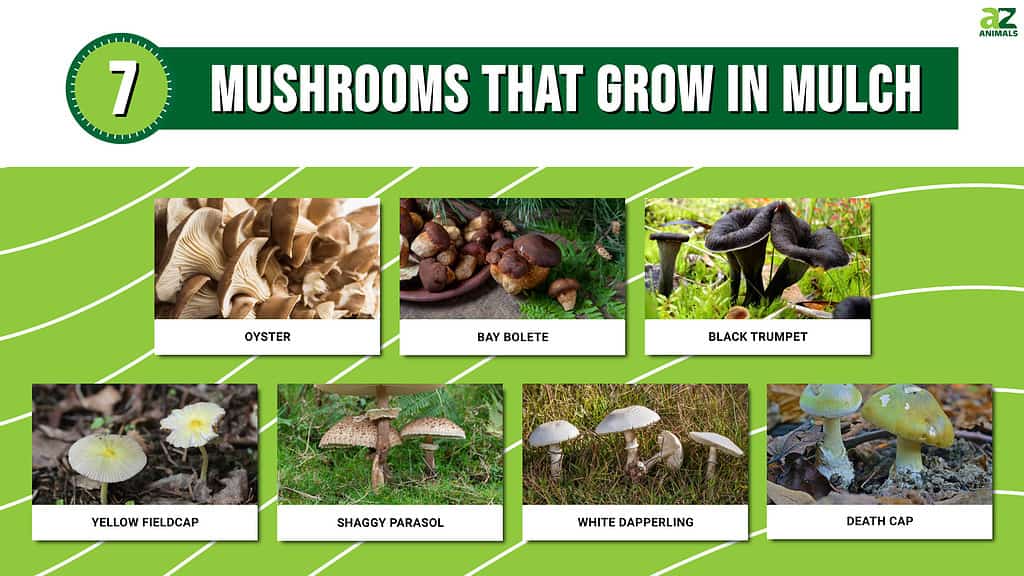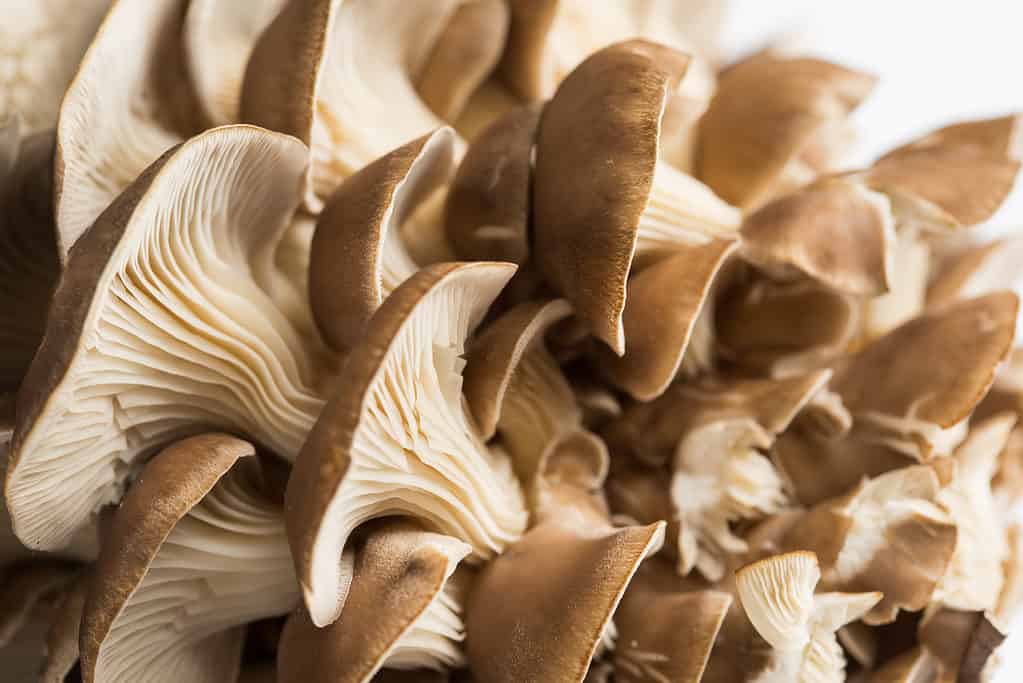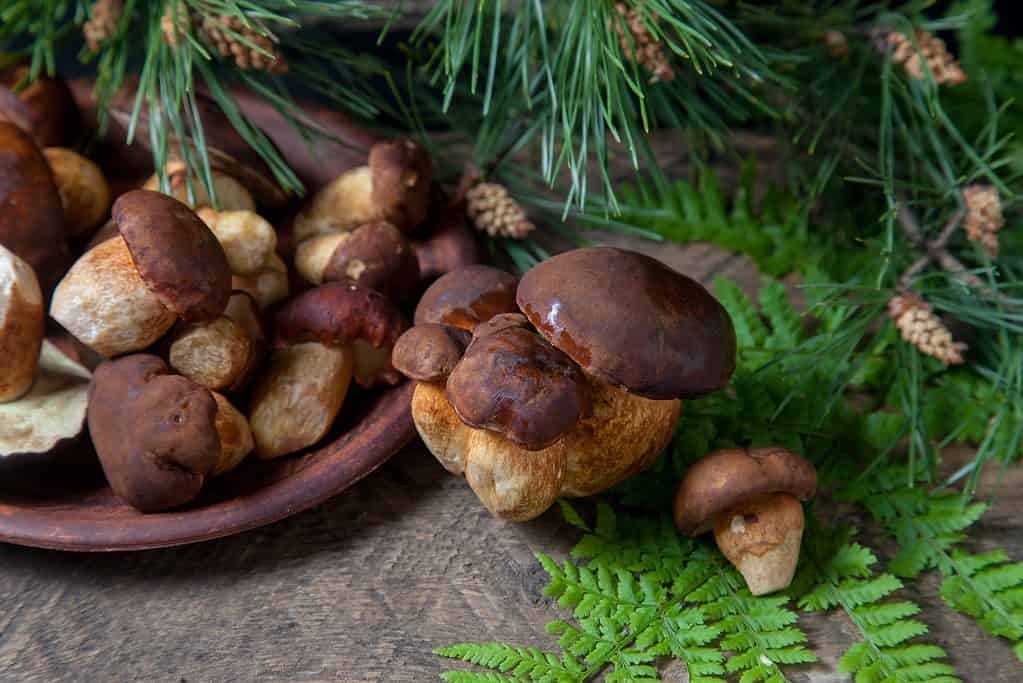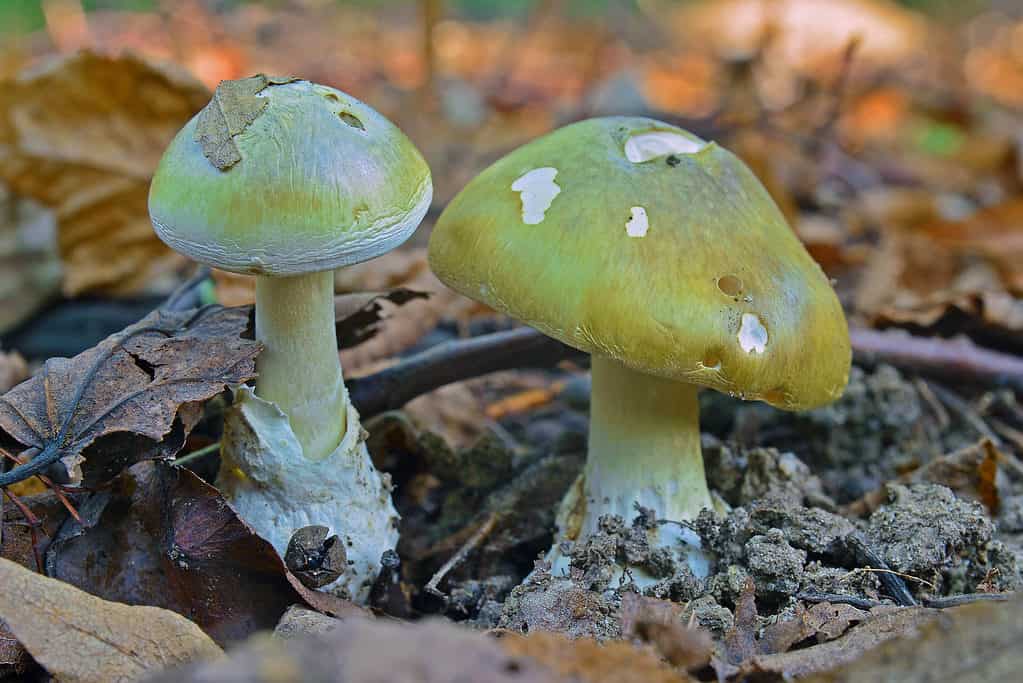Fungi are without a doubt, one of the most interesting types of organisms out there. These decomposers are vital to the environment and flourish in the most unexpected locations, such as dung or mulch. While some mushrooms can have psychoactive effects or may be poisonous, others make for delicious meals! These small marvels can alter the appearance of any garden or landscape through their complex and fragile structures.

Although they may appear insignificant, they serve a vital function in nature and have an intriguing tale to share. In this article, we will delve into mulch-growing mushrooms. We’ll examine their attributes and uncover fascinating details.
Oyster (Pleurotus spp.)

Oyster mushrooms have short stems compared to their much larger cousins, the king oyster mushroom, which has a large, fat stem.
©Tiplyashina Evgeniya/Shutterstock.com
The oyster mushroom is known for its widespread consumption and global commercial significance. It is an edible fungus encompassing a variety of types, including some that flourish in mulch. Bearing the scientific name Pleurotus, this genus of gilled fungi has a delightful flavor and nutritional benefits. Other names for these shrooms are abalone, tree, or oyster mushrooms. They rank among the most extensively produced edible fungi across the globe.
These mushrooms thrive exceptionally well on straw and sugarcane mulch. However, the king oyster variety tends to yield undersized fruits in such conditions.
Habitats for Pleurotus mushrooms span tropical and temperate climates worldwide, and they thrive in diverse environments. They commonly grow on damp tree trunks and decomposing organic materials containing lignin and degrading phenol enzymes. Large-scale cultivation of Pleurotus species utilizes a broad array of agro-substrates, employing simple and cost-effective production methods. China holds the top spot for oyster mushroom production internationally.
The term “Pleurotus” has its roots in the Greek words “pleura” (side) and “otus” (ear). This name reflects the lateral attachment of the mushroom caps to their substrate. Oyster mushrooms are a staple in plant-based dishes. Chefs often incorporate them into stir-fries and sautés. Their uniform thinness makes them a sought-after ingredient, as it enables even cooking compared to other mushroom varieties.
Oyster mushrooms come in both moist and dry forms. They boast a diverse color palette that includes white, cream, grayish-brown, and even shades of lilac. The most prevalent cultivated variety, P. ostreatus, was first produced in the United States in 1900. It has since enjoyed increasing popularity across the globe.
Bay Bolete (Imleria badia)

The fruiting bodies of the bay bolete emerge either individually or in small clusters.
©Kostiantyn Kravchenko/Shutterstock.com
The bay bolete, known scientifically as Imleria badia, is an edible mushroom that can grow in mulch. It lives across Eurasia and North America, typically flourishing in coniferous or mixed forests. They grow either on the forest floor or on decomposing tree stumps. When young, the mushroom has an almost spherical shape that later expands to a diameter of up to 6 inches.
This mushroom is prevalent in coniferous woodlands throughout Europe, ranging from the British Isles to Turkey’s Black Sea Region. It grows from August to November. In Asia, it grows in Jordan, mainland China, and Taiwan. Its North American distribution spans from Eastern Canada to Minnesota and reaches down to North Carolina, with fruiting occurring from July to November.
The fruiting bodies of the bay bolete emerge either individually or in small clusters. They can easily hide behind ferns or pine needles. These mushrooms often appear after rainfall in warm weather and are particularly abundant in damp, shady highland regions. While they typically grow under white pine, spruce, and hemlock trees, they can also grow under deciduous trees like beech. In some instances, this species resides in grassy or mossy areas near the edge of forests.
The bay bolete is a tasty edible mushroom. It is harvested from the Izta-Popo Zoquiapan National Park in central Mexico and sold in local markets. While it can cause allergic reactions in some individuals, its gentle flavor is generally well-liked. Younger specimens are especially appreciated for their taste.
Black Trumpet (Craterellus cornucopioides)

Their caps feature rolled-out edges, wavy rims, and shades of brown, gray, or black.
©SariMe/Shutterstock.com
The black trumpet mushroom is a highly prized fungus that thrives in mulch. Renowned for its rich, smoky taste and delightful fruity scent, this mushroom is a popular choice among culinary enthusiasts. Fortunately for novices, black trumpets are easily identifiable, as there are no poisonous look-alikes.
Finding black trumpets, however, can be somewhat tricky. Their dark coloration and unusual funnel-shaped structure cause them to resemble small black voids on the forest floor. Due to this, people tend to overlook them.
Their caps feature rolled-out edges, wavy rims, and shades of brown, gray, or black. Unlike most mushrooms, black trumpets lack visible gills or spore-producing structures, and their undersides range from smooth to slightly wrinkled.
Black trumpets commonly grow in wooded areas throughout Europe, North America, and East Asia. They favor growing under beech, oak, or other broad-leaved trees, especially in damp locations with calcareous soil. Trumpets tend to grow in clusters, particularly on the west coast. They flourish from summer to winter in California.
Their robust, smoky flavor complements various dishes. Black trumpets excel in soups, sauces, pasta dishes, seafood recipes, or any meal where strong-tasting ingredients won’t overpower their distinct taste.
Yellow Fieldcap (Bolbitius titubans)

This fungus species is widespread throughout both America and Europe and is completely safe for consumption.
©Henri Koskinen/Shutterstock.com
This charming little fungus is frequently in grassy areas and along roadsides. It occasionally emerges in damp woodchip mulch as well. Notable for its rapid growth, it progresses from a yellow “egg on a stick” to a pinkish parasol phase. It transforms into a medium-to-dark brown or light-ochre mushroom in less than a day.
This fungus species is widespread throughout both America and Europe and is completely safe for consumption. Its cap typically ranges from 0.5 to 3 inches in diameter and starts as an egg shape before expanding into a broad, convex form and finally flattening out.
Bolbitius titubans flourishes in regions with wood chip mulch or grass-manured mulch. They typically appear after heavy rainfall or when the mulch is highly humid. Interestingly, these mushrooms tend to avoid growing near cow manure. If you encounter them and wish to remove them, incorporating cow manure into the decomposing mulch can be helpful.
While technically edible, the yellow fieldcap is too small and delicate to hold much culinary appeal. It may cause gastrointestinal issues in some people. Consuming this mushroom is not recommended.
These mushrooms can fruit all year round, as long as there is enough moisture and sunlight. In North America, they are most common during the summer and autumn months.
Shaggy Parasol (Chlorophyllum rhacodes)

Extreme caution is necessary when identifying young, shaggy parasols. They can be easily mistaken for the highly toxic
Chlorophyllum molybdites.
©Stephan Morris/Shutterstock.com
The shaggy parasol mushroom is a prevalent species. They thrive in mulch, especially in areas abundant in grass, wood chips, and other materials that maintain high humidity levels. This prominent agaric boasts a fleshy, white cap adorned with thick brown scales. The spore print and gills of this mushroom are white. Its slim stipe is bulbous at the base without any notable patterns. When sliced, the shaggy parasol releases a strong scent and may exhibit a reddish or maroon hue.
Extreme caution is necessary when identifying young, shaggy parasols. They can be easily mistaken for the highly toxic Chlorophyllum molybdites. These dangerous shrooms cause the highest number of annual mushroom poisonings in North America. To differentiate between the two, look for a white spore print. C. molybdites have a green print and older specimens may have slightly green gills.
Be aware that the shaggy parasol contains toxins that can lead to gastrointestinal distress in some people. As a result, inexperienced individuals should avoid consuming this mushroom. It should only be consumed after cooking. However, approximately one in 25 people may experience stomach discomfort after consuming this mushroom, even when properly cooked.
White Dapperling (Leucoagaricus Leucothites)

The white dapperling often grows on lawns, potentially exposing it to contamination from pesticides used for lawn maintenance.
©LFRabanedo/Shutterstock.com
The white dapperling mushroom, sometimes called the white Agaricus, is part of the agaric fungus family. It grows in various settings, including mulch made of grass clippings and other plant materials. The mushroom cap measures between 1.5 and 6 inches in diameter and features a granular texture. Its color can range from white to gray-brown and may even take on grayish or pinkish hues. When bruised, the mushroom flesh turns yellowish, and the gills adopt a reddish color. The mushroom stipe is generally 2 to 5 inches long and has a wide base with yellow or brown bruising.
The white dapperling mushroom’s poisonous look-alike is the death cap mushroom, often found in grassy urban locations. You can differentiate it by its yellowish or brownish cap, a hanging skirt-like ring, and a cup around its stem base.
People also mistake the green-spored parasol for the white dapperling. This mushroom is distinguishable by its brown-scaled cap, greenish spore print, and more pronounced stem ring. The green-spored parasol flourishes in warm climates and is common in Southern California and the Central Valley.
The white dapperling often grows on lawns, potentially exposing it to contamination from pesticides used for lawn maintenance. Eating this mushroom has caused gastrointestinal issues for numerous individuals. Symptoms appear anywhere from 10 minutes to 10 hours post-ingestion, averaging around 4 hours.
While some people enjoy this mushroom, it is crucial to exercise caution and only eat mushrooms from a clean source. It is advised to begin with a small bite of thoroughly cooked mushrooms when experimenting with this species.
Death Cap (Amanita phalloides)

Consuming even a tiny portion of this mushroom can be fatal, as it may contain multiple times the toxin amount needed to cause death.
©iStock.com/empire331
Among the mushrooms that grow in mulch, one stands out for its dangerous potential. This seemingly innocent mushroom is actually one of the world’s most toxic mushroom species. It accounts for a significant majority of fatal mushroom poisonings. Its scientific name, Amanita phalloides, is also known as the death cap, and for a compelling reason.
Originally native to Europe, this adaptable fungus has spread globally. It flourishes especially well in the San Francisco Bay Area and along the Central Coast during warm, damp winters.
The death cap mushroom features a cap with colors ranging from greenish-yellow to brown, tan, or even white. It may develop a metallic sheen over time. Its size varies from about 1.5 to 6 inches in diameter, beginning as a round or oval shape and becoming convex to flat as it matures. The internal flesh is white and remains unchanged when sliced.
As the mushroom grows and the cap expands, a universal veil initially covers the young mushroom. This eventually forms a volva or bulbous base. Sometimes the volva isn’t visible above ground, and you’ll have to entirely dig up the mushroom for identification.
This lethal mushroom contains three primary toxin types: phallotoxins, virotoxins, and amatoxins. The purpose of these toxins in nature remains unknown. In humans, amatoxins inhibit DNA production, leading to liver and kidney failure and, if untreated, coma and death. Consuming even a tiny portion of this mushroom can be fatal, as it may contain multiple times the toxin amount needed to cause death. Moreover, boiling, cooking, freezing, or drying the mushroom won’t neutralize the toxins. There is no known cure for death cap poisoning.
Summary Of The 7 Mushrooms That Grow In Mulch
| Rank | Mushroom |
|---|---|
| 1 | Oyster |
| 2 | Bay Bolete |
| 3 | Black Trumpet |
| 4 | Yellow Fieldcap |
| 5 | Shaggy Parasol |
| 6 | White Dapperling |
| 7 | Death Cap |
The photo featured at the top of this post is © iStock.com/Jiradelta
The information presented on or through the Website is made available solely for general informational purposes. We do not warrant the accuracy, completeness, or usefulness of this information. Any reliance you place on such information is strictly at your own risk. We disclaim all liability and responsibility arising from any reliance placed on such materials by you or any other visitor to the Website, or by anyone who may be informed of any of its contents. None of the statements or claims on the Website should be taken as medical advice, health advice, or as confirmation that a plant, fungus, or other item is safe for consumption or will provide any health benefits. Anyone considering the health benefits of particular plant, fungus, or other item should first consult with a doctor or other medical professional. The statements made within this Website have not been evaluated by the Food and Drug Administration. These statements are not intended to diagnose, treat, cure or prevent any disease.
Thank you for reading! Have some feedback for us? Contact the AZ Animals editorial team.






